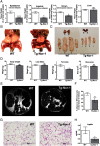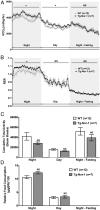Transgenic muscle-specific Nor-1 expression regulates multiple pathways that effect adiposity, metabolism, and endurance
- PMID: 24065705
- PMCID: PMC5427836
- DOI: 10.1210/me.2013-1205
Transgenic muscle-specific Nor-1 expression regulates multiple pathways that effect adiposity, metabolism, and endurance
Abstract
The mRNA encoding Nor-1/NR4A3 is rapidly and strikingly induced by β2-adrenergic signaling in glycolytic and oxidative skeletal muscle. In skeletal muscle cells, Nor-1 expression is important for the regulation of oxidative metabolism. Transgenic skeletal muscle-specific expression of activated Nor-1 resulted in the acquisition of an endurance phenotype, an increase in type IIA/X oxidative muscle fibers, and increased numbers of mitochondria. In the current study, we used dual-energy x-ray absorptiometry and magnetic resonance imaging analysis to demonstrate decreased adiposity in transgenic (Tg) Nor-1 mice relative to that in wild-type littermates. Furthermore, the Tg-Nor-1 mice were resistant to diet-induced weight gain and maintained fasting glucose at normoglycemic levels. Expression profiling and RT-quantitative PCR analysis revealed significant increases in genes involved in glycolysis, the tricarboxylic acid cycle, oxidative phosphorylation, fatty acid oxidation, and glycogen synthesis, in concordance with the lean phenotype. Moreover, expression profiling identified several Z-disc and sarcomeric binding proteins that modulate fiber type phenotype and endurance, eg, α-actinin-3. In addition, we demonstrated that the Tg-Nor-1 mouse line has significantly higher glycogen content in skeletal muscle relative to that in wild-type littermates. Finally, we identified a decreased NAD(+)/NADH ratio with a concordant increase in peroxisome proliferator-activated receptor γ coactivator-1α1 protein/mRNA expression. Increased NADH was associated with an induction of the genes involved in the malate-aspartate shuttle and a decrease in the glycerol 3-phosphate shuttle, which maximizes aerobic ATP production. In conclusion, skeletal muscle-specific Nor-1 expression regulates genes and pathways that regulate adiposity, muscle fiber type metabolic capacity, and endurance.
Figures









Similar articles
-
The orphan nuclear receptor, NOR-1, a target of beta-adrenergic signaling, regulates gene expression that controls oxidative metabolism in skeletal muscle.Endocrinology. 2008 Jun;149(6):2853-65. doi: 10.1210/en.2007-1202. Epub 2008 Mar 6. Endocrinology. 2008. PMID: 18325999
-
The Nuclear Receptor, Nor-1, Induces the Physiological Responses Associated With Exercise.Mol Endocrinol. 2016 Jun;30(6):660-76. doi: 10.1210/me.2015-1300. Epub 2016 May 4. Mol Endocrinol. 2016. PMID: 27144290 Free PMC article.
-
Skeletal muscle-specific expression of PGC-1α-b, an exercise-responsive isoform, increases exercise capacity and peak oxygen uptake.PLoS One. 2011;6(12):e28290. doi: 10.1371/journal.pone.0028290. Epub 2011 Dec 8. PLoS One. 2011. PMID: 22174785 Free PMC article.
-
Constitutively active calcineurin in skeletal muscle increases endurance performance and mitochondrial respiratory capacity.Am J Physiol Endocrinol Metab. 2010 Jan;298(1):E8-E16. doi: 10.1152/ajpendo.00403.2009. Epub 2009 Oct 27. Am J Physiol Endocrinol Metab. 2010. PMID: 19861587
-
Skeletal muscle and nuclear hormone receptors: implications for cardiovascular and metabolic disease.Int J Biochem Cell Biol. 2005 Oct;37(10):2047-63. doi: 10.1016/j.biocel.2005.03.002. Int J Biochem Cell Biol. 2005. PMID: 15922648 Review.
Cited by
-
Intensity-dependent gene expression after aerobic exercise in endurance-trained skeletal muscle.Biol Sport. 2018 Sep;35(3):277-289. doi: 10.5114/biolsport.2018.77828. Epub 2018 Aug 27. Biol Sport. 2018. PMID: 30449946 Free PMC article.
-
IRLnc: a novel functional noncoding RNA contributes to intramuscular fat deposition.BMC Genomics. 2021 Feb 1;22(1):95. doi: 10.1186/s12864-020-07349-5. BMC Genomics. 2021. PMID: 33522899 Free PMC article.
-
Targeting Orphan Nuclear Receptors NR4As for Energy Homeostasis and Diabetes.Front Pharmacol. 2020 Nov 27;11:587457. doi: 10.3389/fphar.2020.587457. eCollection 2020. Front Pharmacol. 2020. PMID: 33328994 Free PMC article. Review.
-
The nuclear receptor NOR-1 regulates the small muscle protein, X-linked (SMPX) and myotube differentiation.Sci Rep. 2016 May 16;6:25944. doi: 10.1038/srep25944. Sci Rep. 2016. PMID: 27181368 Free PMC article.
-
Effect of aerobic training on baseline expression of signaling and respiratory proteins in human skeletal muscle.Physiol Rep. 2018 Sep;6(17):e13868. doi: 10.14814/phy2.13868. Physiol Rep. 2018. PMID: 30198217 Free PMC article.
References
-
- Owen OE, Reichard GA Jr, Boden G, Patel MS, Trapp VE. Interrelationships among key tissues in the utilization of metabolic substrate. In Katzen HE, Mahler RJ, eds. Advances in Modern Nutrition. New York, NY: John Wiley & Sons; 1978:517–550.
Publication types
MeSH terms
Substances
LinkOut - more resources
Full Text Sources
Other Literature Sources
Molecular Biology Databases
Miscellaneous

